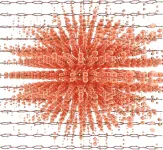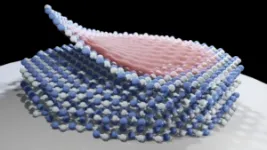(Press-News.org) A new leaf has turned in scientists' hunt for developing cutting-edge materials used in organic light-emitting diode (OLED) TV's, touchscreens, and more. The advance involves the polaron, a quasiparticle consisting of an electron and its surrounding distortions of atoms in a crystal lattice.
Simulations on the Texas Advanced Computing Center's (TACC) Frontera supercomputer have helped scientists map for the first time the conditions that characterize polarons in 2D materials, the thinnest materials that have ever been made.
"We charted a map to indicate in which materials polarons should be found, under what conditions, and the characteristics of their properties," said Feliciano Giustino, professor of Physics and the W. A. ‘Tex' Moncrief, Jr. Chair of Quantum Materials Engineering at the Oden Institute for Computational Engineering and Sciences (Oden Institute) and the Department of Physics, College of Natural Sciences, The University of Texas at Austin.
Understanding polarons can help improve the performance and efficiency of devices such as touchscreens for phones and tablets, and the organic light-emitting diodes of OLED TVs, which rely on electric charge transport through polarons.
What's more, generating hydrogen fuel from the splitting of water by sunlight is considered the ‘holy grail' of energy science, a process which can be achieved through charge transport from polarons in key materials such as titanium dioxide.
Giustino is the lead author on work published February 2023 in Nature Physics. In it, he and study co-author Weng Hong Sio of the Oden Institute and the University of Macau determined the fundamental properties of polarons in 2D materials using quantum mechanical theory and computation.
Little has been known about polarons in 2D materials, until now. Polarons have been well-studied theoretically over the past 100 years, and characterized experimentally for three-dimensional bulk solids.
Giustino and Sio focused on atomically-thin crystal monolayers of hexagonal boron nitride (h-BN) on graphene as a case study, where polarons were computed and compared in the bulk crystal and in the monolayer. Next, they created a generalized model of polarons in 2D materials.
"Our aim was to understand where one can find polarons in two dimensions, and what are their properties. To do this, we used a new computational method that we developed," Giustino said.
Giustino at the Oden Institute invented EPW, an open-source Fortran and message passing interface (MPI) code that calculates properties related to electron-phonon interaction using Density-Functional Perturbation Theory and Maximally Localized Wannier Functions. This code is currently developed by an international collaboration led by the Oden Institute.
"We used supercomputers to perform the calculations, primarily those of DOE (Argonne Leadership Computing Facility and National Energy Research Scientific Computing) as well as Frontera at TACC. EPW is something that we optimized very heavily on Frontera," Giustino said.
During TACC's Texascale Days, Giustino was awarded access to the full machine, allowing his group to perform full system runs on all 448,000 CPU cores of Frontera.
"Thanks to DOE support, we've been refactoring the EPW for exascale computing over the past 4 years," Giustino said. "TACC's Frontera supercomputer has helped us with this effort. We managed to refactor the EPW code to achieve 92% of ideal scaling. The ability to access the entire machine within Texascale Days has been absolutely critical to bring us to where we are now with the code."
TACC's Frontera supercomputer, funded by the National Science Foundation (NSF), is the most powerful academic system in the U.S. Frontera's Characteristic Science Applications (CSA) program is part of the planning and early science program for the NSF's Leadership-Class Computing Facility (LCCF), which will be 10 times as powerful as Frontera.
"TACC provided us with the opportunity to develop the codes on full scale systems that has not been possible anywhere else," Giustino said.
His EPW code is one of 21 CSA projects selected by TACC to be benchmarked and optimized for the LCCF — these latest polaron simulations are linked with Giustino's CSA project.
What's more, Giustino continues his strong collaboration with TACC through a recent grant to develop software to design new materials, awarded from the NSF Office for Advanced Cyberinfrastructure through the Cyberinfrastructure for Sustained Scientific Innovation (CSSI) program. The grant will fund the development of software to design new materials.
The Department of Energy (DOE) funded Giustino's latest work with polarons under the DOE Office of Science, Basic Energy Sciences, Computational Materials Sciences award no. DE-SC0020129.
"The National Energy Research Scientific Computing Center (NERSC) has provided the main resources that we use for this DOE project. We ran a significant fraction of our calculations on the Cori and Perlmuttersupercomputers at NERSC," Giustino said.
The calculations pertain to the formation energies, wave functions, and atomic displacements of polarons, a quantum wave packet consisting of an electron "dressed" by a cloud of atomic vibrations.
Electrons alone behave like delocalized waves, and polarons behave differently in that the wave packet jumps from one lattice site to another. "This ‘hopping transport' regime confers the material with novel properties and has implications on the design of materials for electronics," Giustino said.
The packet extends over 10 nanometers, encompassing about 30,000 atoms of boron and nitrogen, considering all the interactions between atoms. This kind of calculation isn't possible currently using standard density functional theory methods.
"We recast this problem into the solution of a very large nonlinear eigenvalue problem. Then we used supercomputers to solve this gigantic linear algebra problem," Giustino said.
"We believe that with these new methods that we developed through the EPW code, we are now capitalizing on and supporting experimental data and see new directions in materials design," he added.
Said Giustino: "The materials that we know today are just a tiny fraction of what is possible. Supercomputers are key to exploring this valuable and gigantic space without having to first invest billions into experimental synthesis and material characterization. Computation gives scientists a first pass to more easily see what is possible, something which I strongly advocate for and want the U.S. to maintain leadership in materials research through sustained support for high performance computing."
END
New simulation reveals secrets of exotic form of electrons called polarons
Conditions mapped through simulations on DOE and TACC supercomputers for predicting polarons in 2D materials
2023-03-22
ELSE PRESS RELEASES FROM THIS DATE:
New survey finds COVID-19 pandemic changed public’s view of obesity
2023-03-22
Nearly a third of Americans (29%) say COVID-19 made them more worried than ever about having obesity prompting about 28 million people to consider weight-loss methods they hadn’t thought about before the pandemic began, including nearly 6.4 million thought about turning to either weight-loss surgery or taking prescription anti-obesity drugs for the first time, according to a new survey whose findings were published online in the peer-reviewed journal, Surgery for Obesity and Related Diseases (SOARD).
Another nearly 1 in 5 people (18%) said they were more likely to initiate a discussion about their weight with their physician specifically because ...
Searching for life with space dust
2023-03-22
Following enormous collisions, such as asteroid impacts, some amount of material from an impacted world may be ejected into space. This material can travel vast distances and for extremely long periods of time. In theory this material could contain direct or indirect signs of life from the host world, such as fossils of microorganisms. And this material could be detectable by humans in the near future, or even now.
When you hear the words vacuum and dust in a sentence, you may groan at the thought of having ...
Hunting Venus 2.0: Scientists sharpen their sights
2023-03-22
With the first paper compiling all known information about planets like Venus beyond our solar system, scientists are the closest they’ve ever been to finding an analog of Earth’s “twin.”
If they succeed in locating one, it could reveal valuable insights into Earth’s future, and our risk of developing a runaway greenhouse climate as Venus did.
Scientists who wrote the paper began with more than 300 known terrestrial planets orbiting other stars, called exoplanets. They whittled the list down to the five most likely to ...
New research reveals a potential mechanism for how coffee may reduce the risk of type 2 diabetes
2023-03-22
New scientific research investigates inflammation and insulin resistance in habitual coffee drinkers to understand how coffee may reduce the risk of type 2 diabetes (T2D), mediated by inflammatory biomarkers in the body 1.
Drinking just one additional cup of coffee per day was associated with a 4-6% lower risk of T2D among participants in two large prospective cohort studies, which was partly explained by lower levels of inflammation1.
Experts consider consuming up to 400mg of caffeine (3-5 cups of coffee) per day to be a moderate and safe amount for most adults. For pregnant or lactating women, caffeine intake should be reduced to 200mg per day2.
These results further support previous ...
Big firms are failing to reduce unconscious bias against disabled people
2023-03-22
Working for a big company or in an HR role does not lower the likelihood of showing unconscious bias against disabled people at work, a new study finds.
Researchers say this is ‘surprising’ because of the money many large firms spend on EDI and unconscious bias training – in 2017 up to $8bn in the US alone – and the fact HR professionals are often specifically trained in EDI issues.
The research, a collaboration between the University of Exeter’s Business School and Medical ...
Does birth by cesarean section affect children’s academic performance and intelligence?
2023-03-22
In a study of Danish children born between 1978–2000, chances of graduating from lower and upper secondary education were significantly lower for children born by cesarean section (CS). However, differences in grade point averages and intelligence scores were very small. The study, which is published in Acta Obstetricia et Gynecologica Scandinavica, also found that males born by CS had a lower likelihood of appearing before a conscription board for drafting into the military.
In Denmark, most students are 6–16 years old while in lower secondary education (LSE) and 16–17 years old when initiating ...
Can moderate dietary salt restriction help patients with hypertension?
2023-03-22
Results from a clinical trial published in the Journal of Internal Medicine reveal several health benefits of moderate salt restriction in patients on standard medical treatment for primary aldosteronism.
Primary aldosteronism—a condition in which the adrenal glands make too much of the hormone aldosterone—is a common cause of secondary hypertension. The combination of aldosterone excess and high dietary salt intake leaves affected patients with a higher risk of cardiovascular disease than patients with hypertension ...
How fisheries threaten seals and sea lions in South America
2023-03-22
Seals, sea lions, and fur seals are at risk from interactions with fisheries and aquaculture, as they can become entangled in nets or cages, and drown. In a study published in Mammal Review, investigators analyzed research from the last 25 years on operational and biological interactions between these marine mammals and fisheries and aquaculture activities in South American waters.
The authors found that two species are primarily involved in interactions in many countries: the South American sea lion Otaria flavescens and the South American fur seal Arctocephalus australis. ...
Does care during pregnancy differ based on patient race in the United States?
2023-03-22
In an analysis of perinatal care provided in the United States, investigators found few differences by race for care that was based on guidelines or expert recommendations; however, discretionary care (for which professional recommendations or guidelines do not exist) varied by race.
The analysis, which is published in Birth, included information from the electronic health records for 7,056 women who delivered infants within a large hospital system between 2012 and 2018. Compared with Non-Hispanic white women, Non-Hispanic Black women were ...
Are there sex-based differences in brain development during early childhood?
2023-03-22
New research published in Human Brain Mapping reveals sex differences and developmental changes in the brain’s white matter—which provides communication between different parts of the brain—in healthy, typically developing infants and 5-year-olds.
The results, which highlighted sexual dimorphism in brain structure during development with significant detectable differences in multiple regions at the age of 5 years, agree with prior studies showing earlier brain development in females.
Also, changes in white matter asymmetry patterns occurred during early childhood, and in 5-year-olds the pattern already resembled adult-like patterns.
“We observed sex differences ...
LAST 30 PRESS RELEASES:
A researcher’s long quest leads to a smart composite breakthrough
Urban wild bees act as “microbial sensors” of city health.
New study finds where you live affects recovery after a hip fracture
Forecasting the impact of fully automated vehicle adoption on US road traffic injuries
Alcohol-related hospitalizations from 2016 to 2022
Semaglutide and hospitalizations in patients with obesity and established cardiovascular disease
Researchers ‘listen in’ to embryo-mother interactions during implantation using a culture system replicating the womb lining
How changing your diet could help save the world
How to make AI truly scalable and reliable for real-time traffic assignment?
Beyond fragmented markets: A new framework for efficient and stable ride-pooling
Can shape priors make road perception more reliable for autonomous driving?
AI tracks nearly 100 years of aging research, revealing key trends and gaps
Innovative techniques enable Italy’s first imaging of individual trapped atoms
KIER successfully develops Korea-made “calibration thermoelectric module” for measuring thermoelectric device performance
Diversifying US Midwest farming for stability and resilience
Emphasizing immigrants’ deservingness shifts attitudes
Japanese eels, climate change, and river temperature
Pusan National University researchers discover faster, smarter heat treatment for lightweight magnesium metals
China’s 2024 Gastroenterology Report: marked progress in endoscopy quality and disease management
Pusan National University researchers uncover scalable method for ultrahigh-resolution quantum dot displays
Researchers use robotics to find potential new antibiotic among hundreds of metal complexes
Gut bacteria changes at the earliest stages of inflammatory bowel disease
Scientists develop new way to “listen in” on the brain’s hidden language
Brain research: “Pulse generators” grow and shrink as memories are formed
For teens, any cannabis use may have impact on emotional health, academic performance
School meals could unlock major gains for human and planetary health
Menopause hormone therapy does not appear to impact dementia risk
Signature patterns of brain activity may help predict recovery from traumatic brain injury
Dresden study uncovers new key mechanism in cancer cells
New species are now being discovered faster than ever before, study suggests
[Press-News.org] New simulation reveals secrets of exotic form of electrons called polaronsConditions mapped through simulations on DOE and TACC supercomputers for predicting polarons in 2D materials




